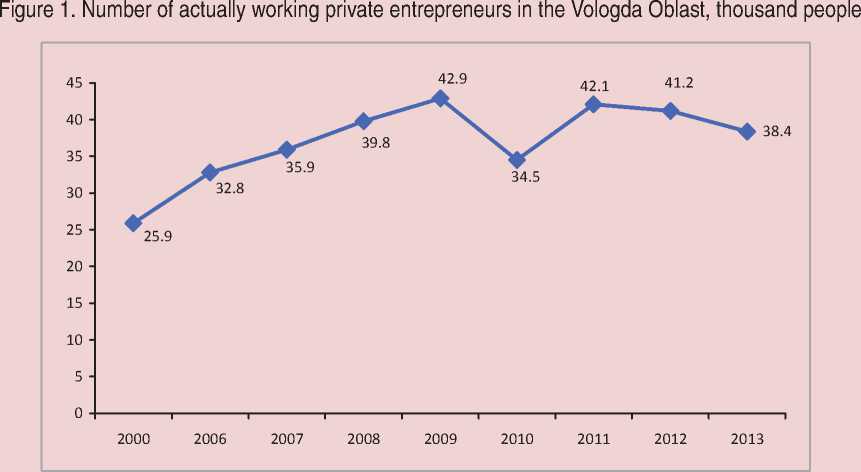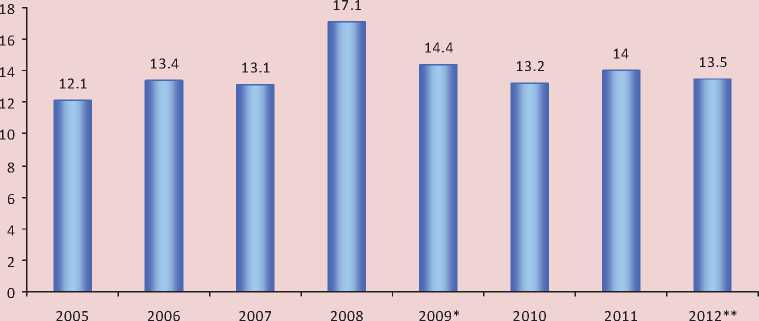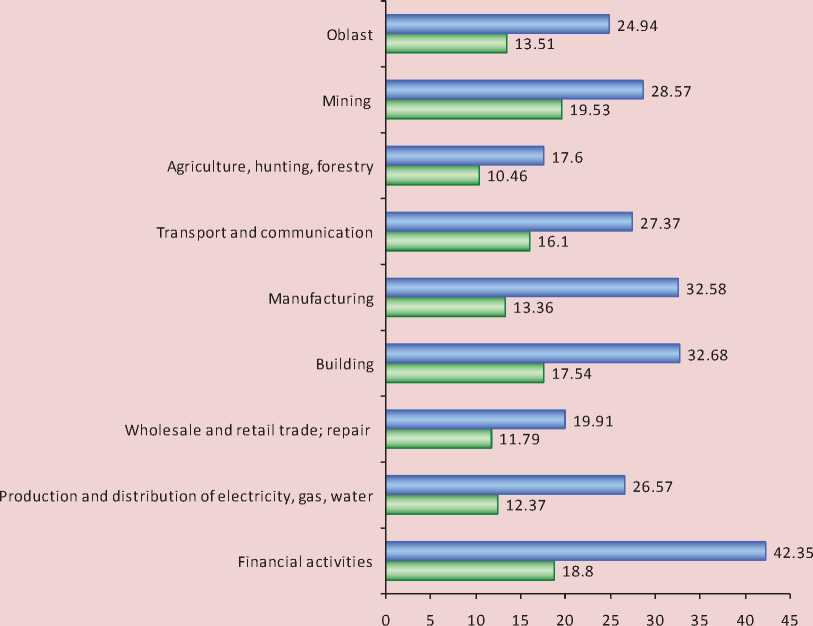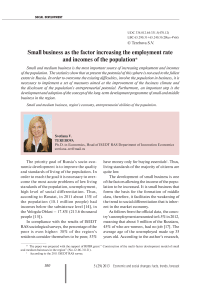Small business as the factor increasing the employment rate and incomes of the population
Автор: Terebova Svetlana Viktorovna
Журнал: Economic and Social Changes: Facts, Trends, Forecast @volnc-esc-en
Рубрика: Social development
Статья в выпуске: 5 (29) т.6, 2013 года.
Бесплатный доступ
Small and medium business is the most important source of increasing employment and incomes of the population. The statistics show that at present the potential of this sphere is not used to the fullest extent in Russia. In order to overcome the existing difficulties, involve the population in business, it is necessary to implement a set of measures aimed at the improvement of the business climate and the disclosure of the population’s entrepreneurial potential. Furthermore, an important step is the development and adoption of the concept of the long-term development programme of small and middle business in the region.
Small and medium business, region's economy, entrepreneurial abilities of the population
Короткий адрес: https://sciup.org/147223502
IDR: 147223502 | УДК: 334.012.64:331.5(470.12)
Текст научной статьи Small business as the factor increasing the employment rate and incomes of the population
Indicator Japan Thailand UN USA China Russia SME share in the total number of organizations % 99.7 99.8 99.8 99.7 99.8 33.3 Share of SME employees in the total number of the employees of all enterprises, % 70.0 75.4 69.7 50.3 82.0 20.9 Sources: Conditions for small-business development using the example of Russia and China. Available at: ; Small business in China. Available at: kapitalist/ archive/2007/19/635/; Business in the region: current state, perspectives: monograph. Terebova S.V., Podolyakin O.V., Egorikhina S.Yu. Vologda: ISEDT RAS, 2011.
Sources: Official website of the Federal State Statistics Service. Available at: ; Unified interagency information and statistical system. Available at: ; Small and medium business in Russia. 2009: statistical digest. Rosstat. Moscow, 2009.
Sources: Official website of the Federal State Statistics Service. Available at: ; Unified interagency information and statistical system. Available at: ; Small and medium business in Russia. 2009: statistical digest. Rosstat. Moscow, 2009.
The number of employees of small enterprises increased in the 2000–2008 period (tab. 4) . However, in 2009–2011 it reduced by 23%, i.e. more than 15 thousand people. One of the reasons for such dynamics is the financial and economic crisis that began in September of 2008 and led to increased tariffs, while at the same time reducing the demand for products/ services of enterprises. The policy of the tax authorities with regard to the subjects of small business has not changed at that. Moreover, in compliance with the Federal Law “On the development of small and medium enterprises in the Russian Federation” [1], since 2008 micro-enterprises (with the personnel of 15 people) were singled out of small enterprises (with number of employees from 16 to 100 people), that also facilitated the reduction in the number of employees in the “small enterprises” group.
The largest number of the employed in small business is concentrated in the sphere of trade (25.4%), real estate operations (18.1%), manufacturing industry (17.5%). Such distribution of employees corresponds to the structure of small business, which is characterized by low level of diversification: basic share of trade and real estate operations, totally amounting to over 50% [17]. Low costs and high turnover of capital above all accounts for the attractiveness of this sector of activity.
In the period under review the following changes occurred in the distribution of the number of employees of small enterprises by types of economic activities (tab. 5) . The number of the employed increased by 8% at the enterprises engaged in operations with real estate, lease and rendering of services, but on the contrary decreased in construction and agriculture by 8% and 6%, respectively. These transformations are the consequence of changes in the structure of small business.
Thus, the number of enterprises engaged in operations with real estate, lease and rendering of services increased by 7% in 2012, as compared to 2005, which is probably related to the state policy of reforming housing and utility sector. Due to the new Housing Code enacted in 2005, the approaches to managing the housing and utility complex have been radically changed. Self-management (Homeowners Association) was declared inefficient and was replaced by professional management represented by private management companies [13] that promoted the emergence of small business in housing and utility sector.
Table 5. Distribution of the number of employees of small enterprises by types of economic activities, %
|
Types of economic activities |
Year |
Absolute deviation in 2012 – 2005 |
|||
|
2005 |
2008 |
2011 |
2012* |
||
|
Wholesale and retail trade; repair of vehicles, motorcycles, household goods and personal appliances |
22.6 |
21.9 |
26.7 |
25.4 |
2.8 |
|
Operations with real estate, lease and rendering of services |
10.5 |
10.5 |
14.9 |
18.1 |
7.6 |
|
Manufacturing |
19.4 |
17.3 |
18.4 |
17.5 |
-1.9 |
|
Building |
20.8 |
23.7 |
12.4 |
13.1 |
-7.7 |
|
Agriculture, hunting |
14.8 |
13.3 |
11.6 |
9 |
-5.8 |
|
Transport and communication |
6.4 |
5.4 |
5.4 |
6 |
-0.4 |
|
Hotels and restaurants |
1.1 |
2.8 |
4.4 |
5 |
3.9 |
|
Production and distribution of electricity, gas and water |
0.6 |
1.1 |
2.93 |
3.1 |
2.5 |
|
Healthcare and social services |
0.8 |
0.5 |
0.9 |
1.2 |
0.4 |
|
Provision of other housing, social and personal services |
2.1 |
2.6 |
1.32 |
1 |
-1.1 |
|
Financial activities |
0.3 |
0.3 |
0.5 |
0.22 |
-0.08 |
|
Mining |
0.0 |
0.2 |
0.32 |
0.2 |
0.2 |
|
Education |
0.1 |
0.1 |
0.12 |
0.1 |
0 |
|
Fishing, fish breeding |
0.5 |
0.3 |
0.11 |
0.08 |
-0.42 |
|
TOTAL |
100 |
100 |
100 |
100 |
|
* Data for January–September of 2012.
Sources: Small business of the oblast: statistical digest. Vologdastat. Vologda, 2008; Small business of the oblast: statistical digest.
Vologdastat. Vologda , 2009; Small business of the Vologda Oblast in January–September of 2012.
Moreover, the growing number of enterprises in this sphere is connected with the development of real estate market (including realtor services).
The number of small enterprises in the sphere of construction and agriculture decreased by 3% and 3.5% respectively. The percentage of shutdown enterprises is lower than the percentage of the employed at these enterprises. This may indicate forced dismissals, pursued by enterprises in order to optimize activities.
Active engagement of employees under the terms of secondary employment is typical of small business. Thus, in 2012 along with workers on payroll, about four thousand of external part-time workers and employees providing work under civil law contracts were engaged at enterprises, accounting for 6% of the total number of employees of small enterprises.
Private entrepreneurs create jobs as well. The number of private entrepreneurs was observed to increase by 66% in the Vologda Oblast for the 2000–2009 period: 17 thousand people set up their own business (fig. 1) .
Since 2009, the region has been implementing a programme to reduce labour market tensions, providing arrangements for self-employment of the unemployed citizens.
In 2012 the trend was toward the reduction in the number of private entrepreneurs – over three thousand of unincorporated businesses were shut down in the period from December 2012 to January 2013 alone [4] (for comparison: about 4 thousand over the first half of 2012) 3. It is most likely related to the fact that social tax burden on small businesses and private entrepreneurs has increased since 2011. Total payroll tax rate made up 34% as against previous 14% from employee wages as social taxes for enterprises, using simplified tax system, and 26%

Sources: Small business of the Vologda Oblast in 1996–2001: trends and priority directions for further development: research and information note. VSCC CEMI RAS. Vologda, 2002. Available at: ; Small and medium business in the Vologda Oblast. 2010: statistical digest. Vologdastat. Vologda, 2010; Small business of the Vologda Oblast in January-September of 2012: statistical digest. Vologdastat. Vologda, 2012.
for enterprises, using general taxation system [6]. In addition, the limiting value base for the assessment of insurance payments increased by more than 11% in 2011, and by 11% in 2012 as compared to the previous year.
If the situation is not changed, the process of curtailing activities, small enterprises and unincorporated businesses will be likely to expand, negatively affecting the municipal budget replenishment (55% of private entrepreneurs falls at the districts of the Oblast). Besides, it can lead to the fall in the wages of employees of small enterprises, the living standards of the region’s population, aggravation of social tension.
In the 2005– 2008 period the average monthly wages of employees of small enterprises increased by 41% up to 17 thousand rubles (fig. 2) . In 2009 it decreased by almost 20% as compared to 2008, due to financial and economic crisis, which resulted in the decline in the companies’ turnover.
The highest income is paid to the employees of enterprises, engaged in financial activities, mining operations, although the share of such workers in the total number of employees hardly exceeds 2% (fig. 3) . Wages in the sphere of financial activity are two times higher than in agriculture and forestry.
In the wholesale and retail trade, repair of vehicles, motorcycles, household goods and personal appliances, accounting for the highest percentage of employees, the fund of accrued wages is observed to be low – about 12 thousand rubles monthly per one employee.
Throughout the period under review the wage level of employees at small enterprises remains low – only 60% of the average for the region. In the author’s opinion, this can be explained by hidden wages, as well as small turnover of small enterprises as compared to big and medium business. In the 2008–2011 period, the turnover per one organization decreased by 13%, capital investments declined 6-fold (tab. 6) .
Figure 2. Average monthly wages of an employee at a small enterprise of the Vologda Oblast (in comparable prices for 2012), thousand rubles

п Average monthly wages of an employee, thousand rubles
* Including microenterprises.
** January–September.
Sources: Official website of Federal State Statistics Service. Available at: ; Unified interagency information and statistical system. Available at:
The share of profitable organizations remained the same, however, the profitability of sold goods, being at a low level anyway, fell by more 1.2%. This may indicate an increase in the prime cost of produced products/ services rendered, caused by rising energy prices, fuel and lubricants, equipment, as well as due to the use of obsolete equipment and technologies.
Small enterprises operating in the region, are characterized by high degree of fixed capital depreciation, particularly in mining (59%), transport and communication (44%), construction (43%), agriculture (40%), manufacturing (37%). The decline in investments in small business development, low profitability of enterprises induces the shortage of financial resources for modernization and asset replacement. At the same time, it is problematic to produce competitive products using worn-out equipment. Russia’s accession to WTO makes this problem particularly acute since enterprises, in fact, actually end up in the open markets. According to the survey, only 16% of enterprises have high level of competitiveness in the international market4 [5]. The respondents noted high export duties (37.1%), high cost and duration of customs clearance (35.5%), lack of funds for advertising (30.6%) among the barriers hindering active promotion of domestic product in the international markets.
The revealed tendencies allow concluding that the increase in the number of the region’s enterprises is quantitative, not qualitative. The situation in this sphere can be described as crisis one. The absence of favourable business environment seems to be among the main reasons behind it5.
Figure 3. Average monthly wages of employees at small enterprises (excluding microenterprises), organizations not belonging to small businesses by separate types of economic activities for 2012, thousand rubles

□ Organizations not belonging to small businesses □ Small enterprises (excluding microenterprises)
Source: Small business in the Vologda Oblast in 2012: statistical bulletin. Vologdastat. Vologda, 2013.
Table 6. Indicators for evaluating the financial and economic state of small enterprises of the Vologda Oblast
|
Indicator |
Unit |
Year |
|||
|
2008 |
2009 |
2011 |
Absolute deviation 2011–2008 |
||
|
Share of the enterprises in the total number of organizations |
% |
18.3 |
18.9 |
25.3 |
7.0 |
|
Turnover of enterprises per one organization |
million rubles |
14.9 |
12.1 |
12.9 |
-2.0 |
|
Investments in fixed capital per one organization |
million rubles |
0.54 |
0.17 |
0.09 |
-0.45 |
|
share of profitable organizations |
% |
74.7 |
70.1 |
74.2* |
-0.5 |
|
profitability of sold goods, products |
% |
4.2 |
3.2 |
3.0* |
-1.2 |
Table 7. Ways to increase employment and income of the population through the development of small and medium business
Список литературы Small business as the factor increasing the employment rate and incomes of the population
- On small and medium business development of the Russian Federation: Federal Law No.209-FZ of July 24, 2007. Available at: http://www.consultant.ru.
- Support and Development of the Vologda Oblast small and medium businesses for 2013-2016: approved by Decree of the Oblast Government No.1156 of October 3, 2012. Available at: http://www.regionz.ru/index.php?ds=1927255.
- Development of small and medium businesses in the Vologda Oblast for 2009-2012 (edited 04.06.2012): long-term target programme: approved by Decree of the oblast Government No.118 of January 27, 2009 Available at: http://www.smb35.ru/state_support/vrp_118_270109_programme.pdf.
- Data of the Department of the Federal Tax Service for the Vologda Oblast. Available at: www.r35.nalog.ru.
- Considering readiness of the Vologda Oblast export-oriented small and medium enterprises to functioning in the conditions of increasing competition in the process of Russia’s accession to WTO: research report. Action by S.V. Terebova, V.S. Uskov, D.I. Papin, S.S. Morozov, V.N. Makoveyev, Ye.A. Mazilov. Vologda, 2012.
- The results of small and medium business development in Russia for 2011. Available at: http://d290351.u72.ukrhosting.com/subpage67.html#razdel1.
- Small business of the Vologda Oblast in 2011: statistical digest. Vologdastat. Vologda, 2012.
- Small business of the Vologda Oblast in January-September of 2012: statistical digest. Vologdastat. Vologda, 2012.
- Podolyakin O.V., Pleshakov P.S. The terms of entrepreneurial activity in the region. Problems of development of territories. 2012. No. 2. P. 30-35.
- Chepurenko A.Yu., Alimova T.A., Tikhonova N.Ye., Obydennova T.B. The entrepreneurial potential of the Russian society: analysis and recommendations on facilitating the population involvement in small business: final analytical report. Мoscow, 2002.
- Terebova S.V., Podolyakin O.V., Uskov V.S., Egorikhina S.Yu. Business in the region: current state, perspectives: monograph. Vologda: ISEDT RAS, 2011.
- Radchenko M.V., Sokolova G.V. Conditions for small-business development using the example of Russia and China. Available at: http://www.rppe.ru/wp-content/uploads/2011/05/radchenko-mv-sokolova-gv.pdf.
- Housing and utilities reform: managing companies and supply with resources by experts’ estimates. Available at: http://www.energystate.ru/books/files/reforma_zkh.pdf.
- Russia in figures. 2012: concise statistical digest. Rosstat. Мoscow, 2012.
- 2011 statistical yearbook of the Vologda Oblast: statistical digest. Vologdastat. Vologda, 2012.
- Unified interagency information and statistical system. Available at: http://fedstat.ru.
- Statistical data of Federal State Statistics Service. Available at: www.gks.ru.
- Terebova S.V., Pleshakov P.S. Entrepreneurship abilities of population: conception and measuring. Modern research of social problems. 2012. No. 9. Available at: http://sisp.nkras.ru/e-ru/issues/2012/9/terebova.pdf.
- Financial and property state of small business enterprises in the Vologda Oblast in 2008-2010: statistical digest. Vologdastat. Vologda, 2011.
- Report preview Doing Business 2013. Smarter regulations for small and medium-size enterprises. 10th edition. 2013. International Bank for Reconstruction and Development. Washington, DC: The World Bank. Available at: http://www.doingbusiness.org/reports/global-reports/doing-business-2013.
- Small business of the Vologda Oblast in 1996-2001: trends and priority directions for further development: research and information note. VSCC CEMI RAS. Vologda, 2002. Available at: http://www.booksite.ru/fulltext/bui/sne/sss/mall/2.htm
- Small and medium business in the Vologda Oblast. 2010: statistical digest. Vologdastat. Vologda, 2010
- Small business of the Vologda Oblast in January-September of 2012: statistical digest. Vologdastat. Vologda, 2012.
- Official website of Federal State Statistics Service. Available at: http://www.gks.ru
- Unified interagency information and statistical system. Available at: http://fedstat.ru
- Small business in the Vologda Oblast in 2012: statistical bulletin. Vologdastat. Vologda, 2013
- Small business in the Vologda Oblast in 2011: statistical digest. Vologdastat. Vologda, 2012
- Financial and property state of small business enterprises in the Vologda Oblast in 2008-2010: statistical digest. Vologdastat. Vologda, 2011.
- Small business of the oblast: statistical digest. Vologdastat. Vologda, 2008
- Small business of the oblast: statistical digest. Vologdastat. Vologda, 2009
- Small business of the Vologda Oblast in January-September of 2012.
- Small and medium business in Russia. 2009: statistical digest. Rosstat. Moscow, 2009
- Conditions for small-business development using the example of Russia and China. Available at: http://www.rppe.ru/wp-content/uploads/2011/05/radchenko-mv-sokolova-gv.pdf
- Small business in China. Available at: http://www.kapitalpress.ru/kapitalist/archive/2007/19/635/


